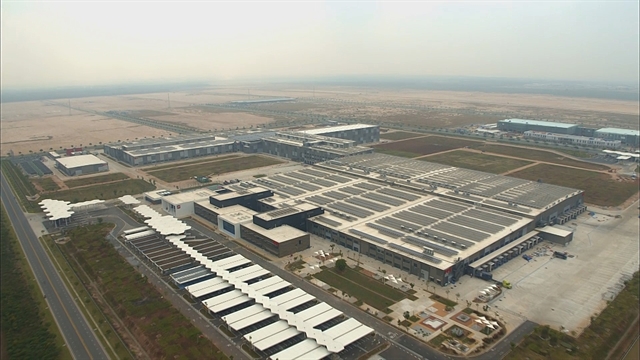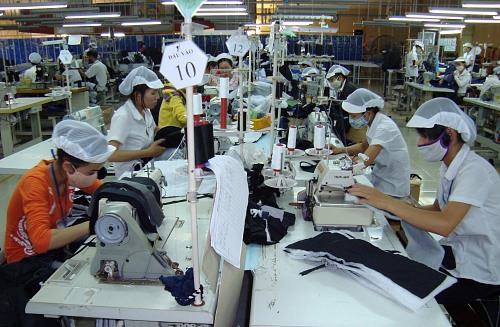 Economy
Economy

Vietnamese businesses have been advised to study the Việt Nam – Eurasian Economic Union (EAEU) free trade agreement so that they can capitalise on opportunities to boost exports to EAEU-member countries.
 |
| The FTA offers Vietnamese firms the opportunity to boost exports of garments and textiles and footwear, wooden products, seafood, fruits and vegetables, and coffee and tea to the region, thanks to lower tariff duties. — Photo baotintuc.vn |
HCM CITY — Vietnamese businesses have been advised to study the Việt Nam – Eurasian Economic Union (EAEU) free trade agreement so that they can capitalise on opportunities to boost exports to EAEU-member countries.
Trade between Việt Nam and the region reached US$3.6 billion last year, a year-on-year increase of 6 per cent, which was modest compared to the potential, Hoàng Quốc Vượng, deputy Minister of Industry and Trade, said at a recent seminar held in HCM City.
The FTA, which took effect on October 5, is expected to expand trade between Việt Nam and five EAEU countries: Russia, Belarus, Kazakhstan, Armenia and Kyrgyzstan, he said.
Under the agreement, 90 per cent of tariff lines have been cut or reduced. Of that amount, 59 per cent of tariff lines were removed right after the agreement took effect, offering great advantages for Việt Nam to compete with other countries in exporting to this region, he said.
With a population of 183 million and GDP of $2.2 trillion, along with increased consumption, the EAEU is a potential market for Vietnamese goods.
Trịnh Thị Thu Hiền of the ministry’s Import-Export Department said the FTA offered Vietnamese firms the opportunity to boost exports of garments and textiles and footwear, wooden products, seafood, fruits and vegetables, and coffee and tea to the region, thanks to lower tariff duties.
However, to enjoy tariff incentives, Vietnamese firms must meet rules of origin, labelling requirements and hygiene and food safety standards, she said.
Many businesses said EAEU countries had cut or reduced tariffs, but they had also applied a trigger safeguard measure on rice, wooden products, footwear and garment and textile products, so exports of these goods were not expected to increase much.
In the garment and textile sector, for instance, the EAEU would cut import tariffs from 10 per cent to zero per cent and apply a trigger safeguard measure.
Under the agreement, a zero import duty would be applied to Việt Nam’s garment and textile products that are no more than 1.5 times of the average volume that Việt Nam exported to the region in the last three years.
If Việt Nam exports exceed this volume, the EAEU will conduct an investigation to decide whether to apply MFN (Most Favoured Nation) tariffs.
Nguyễn Thị Tuyết Mai, deputy general secretary of the Việt Nam Textile and Garment Association, said with the trigger safeguard measure, it would be difficult to increase the amount of garment and textile exports to this area.
In addition, export quota allocations and supervision of export targets will add more administrative procedures to both management agencies and businesses, she said.
As for rice, after the FTA takes effect, the EAEU will cut the import duty from 15 per cent to zero per cent for 10,000 tonnes. More than that volume will be subject to MFN tariff.
Trading difficulties
Lê Ngọc Lâm, deputy general director of the Bank for Investment and Development of Việt Nam, said Russian importers were currently depositing 10-20 per cent of the contract’s total value, and the remaining was paid only after they received the goods. This has caused a lack of trust among trading partners.
Other obstructions include customs procedures and transportation costs, Lâm said, adding that Vietnamese firms had encountered difficulties in obtaining permits to export seafood to the Russian market.
Currently, it takes one to two months to transport goods from Việt Nam to EAEU countries.
Beketjan Jumakhanov, Kazakhstan Ambassador in Việt Nam, said the embassy was promoting co-operation with Việt Nam in the transportation and logistics sectors to shorten the time needed to transport goods between Việt Nam and EAEU region.
Kazakhstan has made efforts to boost trade and economic ties between EAEU and Việt Nam, he said.
Countries involved in the FTA have rapidly simplified their customs clearance processes and have eased payment difficulties to facilitate trade, Lâm said.
Vượng asked localities’departments of Industry and Trade to provide information about the FTA to businesses so that they can take advantage of the agreement and increase exports.
Business representatives at the seminar said that Việt Nam’s foreign trade missions and embassies should provide regular updates about market information in these countries to Vietnamese companies. — VNS




